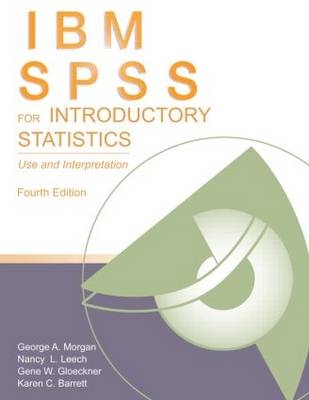
IBM SPSS for Introductory Statistics
Routledge Academic (Verlag)
978-0-415-88229-3 (ISBN)
- Titel erscheint in neuer Auflage
- Artikel merken
Designed to help students analyze and interpret research data using IBM SPSS, this book describes the use of statistics in user-friendly, non-technical language to show readers how to choose the appropriate statistic based on the design, interpret output, and write about the results. The authors prepare readers for all of the steps in the research process, from design and data collection, to writing about the results. Discussions of writing about outputs, data entry and checking, reliability assessment, testing assumptions, and computing descriptive and inferential parametric and nonparametric statistics are included. SPSS syntax, along with the output, is provided for those who prefer this format.
The new edition features:
IBM SPSS version 18 but the book can also be used with older and newer versions
New section on describing demographics and key variables
Expanded discussion of assumptions and effect size measures in several chapters
Expansion of other useful SPSS functions in Appendix A
Examples that meet the new formatting guidelines outlined in the 6th edition of the APA Publication Manual (2010)
Flowcharts and tables to help select the appropriate statistic and interpret statistical significance and effect sizes
Two realistic data sets at www.psypress.com used to solve the chapter problems
Password protected Instructor's Resource materials with PowerPoint slides, answers to interpretation questions, extra SPSS problems, and more found at http://www.psypress.com/ibm-spss-intro-stats .
IBM SPSS for Introductory Statistics, Fourth Edition provides helpful teaching tools:
All of the key IBM SPSS windows needed to perform the analyses
Complete outputs with call-out boxes to highlight key points
Interpretation sections and questions to help students better understand and interpret the output
Lab assignments organized the way students proceed when they conduct a research project
Extra problems for practice in running and interpreting SPSS
Helpful appendices on how to: get started with SPSS; write research questions; and create tables and figures.
An ideal supplement for courses in either statistics, research methods, or any course in which SPSS is used, taught in departments of psychology, education, and other social and health sciences, this book is also appreciated by researchers interested in using SPSS for their data analysis.
George A. Morgan is an Emeritus Professor of Education and Human Development at Colorado State University. He received his Ph.D. in child development and psychology from Cornell University. In addition to writing text books on SPSS and research methods, he has advised many PhD students in education and related fields. Over the past 35 years, he has conducted a program of research on children’s motivation to master challenging tasks. Nancy L. Leech is an Associate Professor of Education and Human Development at University of Colorado Denver. She received her Ph.D. in Education with an emphasis on research and statistics from Colorado State University. She currently teaches master’s and PhD level courses in research, statistics and measurement. Her area of research is promoting new developments and better understanding in applied qualitative, quantitative, and mixed methodologies. Gene W. Gloeckner is an Associate Professor of Education at Colorado State University. He received his Ph.D. in education from The Ohio State University. Much of his writing has focused on research methods issues in both qualitative and quantitative research areas. He has been teaching research design and statistics for more than 25 years. He has advised many doctoral students (over 20) and has served as the research methodologist on many doctoral committees. Karen C. Barrett is a Professor of Human Development and Family Studies with a joint appointment in Psychology at Colorado State University. She received her Ph.D. in psychology from the University of Denver. She is Assistant Department head of HDFS and teaches graduate level research methods and statistics courses. Her research regards emotion regulation and its influence on development; social emotions such as guilt and shame; and family and cultural influences on emotions.
1. Variables, Research Problems and Questions. 2. Data Coding, Entry, and Checking. 3. Measurement and Descriptive Statistics. 4. Understanding Your Data and Checking Assumptions. 5. Data File Management and Descriptive Statistics. 6. Selecting and Interpreting Inferential Statistics. 7. Cross-Tabulation, Chi-Square, and Nonparametric Measures of Association. 8. Correlation and Regression. 9. Comparing Two Groups with t Tests and Similar Nonparametric Tests. 10. Analysis of Variance (ANOVA). Appendix A: Getting Started and Other Useful SPSS Procedures. Appendix B: Writing Research Problems and Questions. Appendix C: Making Tables and Figures. Appendix D: Answers to Odd Numbered Interpretation Questions.
| Erscheint lt. Verlag | 2.9.2010 |
|---|---|
| Verlagsort | London |
| Sprache | englisch |
| Maße | 216 x 279 mm |
| Gewicht | 694 g |
| Themenwelt | Geisteswissenschaften ► Psychologie |
| Mathematik / Informatik ► Mathematik ► Computerprogramme / Computeralgebra | |
| ISBN-10 | 0-415-88229-X / 041588229X |
| ISBN-13 | 978-0-415-88229-3 / 9780415882293 |
| Zustand | Neuware |
| Haben Sie eine Frage zum Produkt? |
aus dem Bereich


